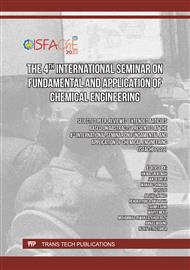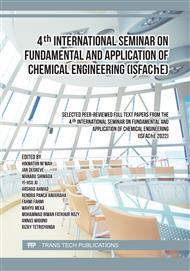[1]
S. Mani, P. Chowdhary, R.N. Bharagava, Textile wastewater dyes: toxicity profile and treatment approaches. In: Emerging and Eco-Friendly Approaches for Waste Management. Springer, Singapore (2019) 219–244.
DOI: 10.1007/978-981-10-8669-4_11
Google Scholar
[2]
S. Zainith, S. Sandhya, G. Saxena, R.N. Bharagava, Microbes an ecofriendly tools for the treatment of industrial waste waters. In: Microbes and Environmental Managemen. Studium Press, New Delhi (2016) 1:78–103.
Google Scholar
[3]
A.H. Jawad, A.M. Kadhum, Y. Ngoh, Applicability of dragon fruit (Hylocereus polyrhizus) peels as low-cost biosorbent for adsorption of methylene blue from aqueous solution: kinetics, equilibrium and thermodynamics studies, Desal. Water Treat. 109 (2018) 231–240.
DOI: 10.5004/dwt.2018.21976
Google Scholar
[4]
S.S. Salih, A. Mahdi, M. Kadhom, T.K. Ghosh, Competitive adsorption of As(III) and As(V) onto chitosan/diatomaceous earth adsorbent, J. Environ. Chem. Eng. 7 (5) (2019) 103407.
DOI: 10.1016/j.jece.2019.103407
Google Scholar
[5]
M. Kadhom, N. Albayati, H. Alalwan, M. Al-Furaiji, Removal of dyes by agricultural waste, Sust. Chem. & Pharmacy 16 (2020) 100259.
DOI: 10.1016/j.scp.2020.100259
Google Scholar
[6]
J. Rana, G. Goindi, N. Kaur, Potential of cellulose acetate for the removal of methylene blue dye from aqueous streams, IJITEE 8 (2020) 2278-3075.
DOI: 10.35940/ijitee.i8628.0881019
Google Scholar
[7]
L. Qiao, S. Li, Y. Li, Y. Liu, K. Du, Fabrication of superporous cellulose beads via enhanced inner crosslinked linkages for high efficient adsorption of heavy metal ions. J. Cleaner Production 253 (2020) 120017.
DOI: 10.1016/j.jclepro.2020.120017
Google Scholar
[8]
H. Ni'mah, D. Puspitasari, A.R. Kurniawan, B. Muiz, A. Roesyadi, F. Kurniawansyah, E.O. Ningrum, 2020. Kinetic study of cationic dye adsorption on cellulose acetate butyrate/poly(L-lactic acid) composite beads, AIP Conf. Proc. 2197 (2020) 120002.
DOI: 10.1063/1.5140959
Google Scholar
[9]
M.N.F. Rofaudin, A.P. Qoidani, D. Puspitasari, H.K. Arnanda, H. Ni'mah, A. Roesyadi, F. Kurniawansyah, E.O. Ningrum, Prediction of continuous adsorption performance of cellulose acetate butyrate/poly(L-lactid acid) composite beads for dye removal, IOP Conf. Series: Mater. Sci. & Eng. 1053 (2021) 012008.
DOI: 10.1088/1757-899x/1053/1/012008
Google Scholar
[10]
B.A.D. Caesario, M.D.R. Ali, D. Puspitasari, H.K. Arnanda, H. Ni'mah, F. Kurniawansyah, E.O. Ningrum, Cellulose-Based beads for cationic dye removal in continuous adsorption. Mater. Today: Proc. 63 (2022) S354–S358.
DOI: 10.1016/j.matpr.2022.03.547
Google Scholar
[11]
H. Ni'mah, E.M. Woo, Coexisting straight, radial, and banded lamellae on the six corners of hexagon-shaped spherulites in poly(L-lactide), Macromol. Chem. Phys. 215 (2014) 1838−1847.
DOI: 10.1002/macp.201400211
Google Scholar
[12]
H. Ni'mah, E.M. Woo, Effects of glycine-based ionic liquid on spherulite morphology of poly(L-lactide), Macromol. Chem. Phys. 216 (2015) 1291−1301.
DOI: 10.1002/macp.201500046
Google Scholar
[13]
H. Ni'mah, E.O. Ningrum, S. Sumarno, D.N. Rizkiyah, I.G.A.G.C. Divta, M. Meiliefiana, M.A. Subaghio, Effect of particle size and crystallinity of cellulose filler on the properties of poly (L-lactic acid): Mechanical property and thermal stability, AIP Conf. Proc. 1840 (2017) 090009-1–090009-8.
DOI: 10.1063/1.4982317
Google Scholar
[14]
H. Ni'mah, R. Rochmadi, E.M. Woo, D.A. Widiasih, S. Mayangsari, Preparation and characterization of poly(L-lactic acid) films plasticized with glycerol and maleic anhydride, Int. J. Technol. 10 (3) (2019) 531-540.
DOI: 10.14716/ijtech.v10i3.2936
Google Scholar
[15]
M. Gericke, J. Trygg, P. Fardim, Functional cellulose beads: Preparation, characterization, and applications. Chem. Rev. 113 (7) (2012) 4812–4836.
DOI: 10.1021/cr300242j
Google Scholar
[16]
M. Behbahani, M.R. Alavi Moghaddam, M. Arami, Techno-economical evaluation of fluoride removal by electrocoagulation process: Optimization through response surface methodology, Desalination 271 (2011) 209–218.
DOI: 10.1016/j.desal.2010.12.033
Google Scholar
[17]
H.F. Haghshenas, A. Khodaii, M. Khedmati, S. Tapkin, A mathematical model for predicting stripping potential of hot mix asphalt, Constr. Build. Mater. 75 (2015) 488–495.
DOI: 10.1016/j.conbuildmat.2014.11.041
Google Scholar
[18]
M. Khedmati, A. Khodaii, H.F. Haghshenas, A study on moisture susceptibility of stone matrix warm mix asphalt, Constr. Build. Mater. 144 (2017) 42–49.
DOI: 10.1016/j.conbuildmat.2017.03.121
Google Scholar
[19]
A. Witek-Krowiak, K. Chojnacka, D. Podstawczyk, A. Dawiec, K. Pokomeda, Application of response surface methodology and artificial neural network methods in modelling and optimization of biosorption process, Bioresour. Technol. 160 (2014) 150–160.
DOI: 10.1016/j.biortech.2014.01.021
Google Scholar
[20]
L. Zhang, Y. Zeng, Z. Cheng, Removal of heavy metal ions using chitosan and modified chitosan: a review, J. Mol. Liq. 214 (2016) 175–191.
DOI: 10.1016/j.molliq.2015.12.013
Google Scholar



